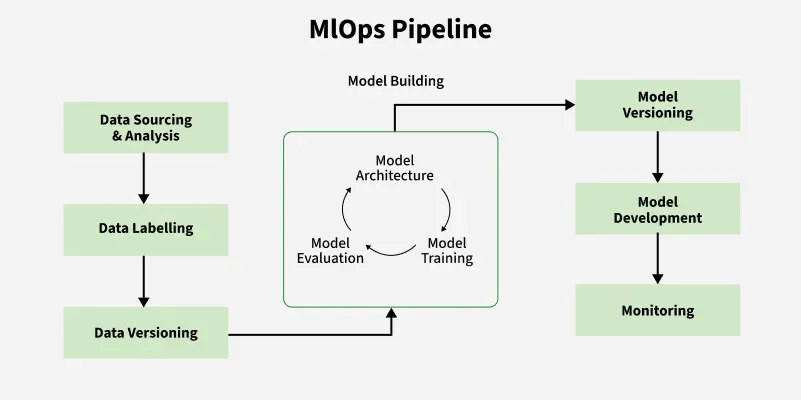
Fortifying Your MLOps Pipeline: A Deep Dive into Azure Machine Learning Security and Preventing Data Exposure
Introduction: The New Frontier of AI Security
The world of artificial intelligence is evolving at a breathtaking pace. Breakthroughs from research labs like Google DeepMind News and Meta AI News are rapidly integrated into production systems. Frameworks like TensorFlow, PyTorch, and JAX are the bedrock of modern model development, while platforms such as Azure Machine Learning, AWS SageMaker, and Vertex AI provide the scalable infrastructure to train and deploy them. However, this rapid innovation brings a new set of challenges, with security being paramount. As MLOps pipelines become more complex, integrating dozens of open-source components from the Hugging Face News ecosystem to experiment trackers like MLflow News, the potential attack surface expands dramatically.
A common, yet often overlooked, vulnerability lies not in sophisticated attacks but in simple misconfigurations. The default settings of many powerful tools, designed for ease of use, can inadvertently lead to the exposure of sensitive information. One of the most critical risks is the unintended logging of access tokens, API keys, and other credentials. These secrets, if leaked, can grant unauthorized access to your entire cloud environment, compromising data, models, and infrastructure. This article provides a comprehensive technical guide to hardening your Azure Machine Learning News workspace, focusing on practical steps to prevent sensitive data leakage, manage identities securely, and adopt a defense-in-depth security posture for your AI workloads.
Section 1: Understanding the Vulnerability: The Peril of Verbose Logging
In the quest for debuggability, developers often configure logging to be as verbose as possible. While invaluable during development, this practice can be dangerous in production. Many SDKs and libraries, including those used for cloud authentication, may include sensitive data in the string representations (`__str__` or `__repr__` methods) of their objects for debugging purposes. When a generic logger captures these objects, it can inadvertently write credentials to log files, Application Insights, or other monitoring systems.
Consider a typical scenario where a data scientist is authenticating to Azure. A common, but less secure, method involves using a service principal with a client secret. In a misconfigured logging setup, the authentication object itself might be logged.
The Pitfall: A Common but Insecure Pattern
Let’s examine a code snippet that demonstrates this potential vulnerability. Here, we configure a basic logger and then attempt to log the credential object. While this specific SDK might not print the secret directly, other libraries or misconfigured handlers could expose parts of the authentication context, which could be pieced together by an attacker.
import logging
import os
from azure.identity import ClientSecretCredential
from azure.ai.ml import MLClient
# Configure a verbose logger
logging.basicConfig(level=logging.INFO, format='%(asctime)s - %(name)s - %(levelname)s - %(message)s')
# INSECURE: Loading credentials from environment variables can be risky if not managed well.
# An attacker with access to the compute instance could read these.
tenant_id = os.environ.get("AZURE_TENANT_ID")
client_id = os.environ.get("AZURE_CLIENT_ID")
client_secret = os.environ.get("AZURE_CLIENT_SECRET") # The sensitive secret!
subscription_id = "your-subscription-id"
resource_group = "your-resource-group"
workspace = "your-ml-workspace"
try:
# Create a credential object
credential = ClientSecretCredential(tenant_id=tenant_id,
client_id=client_id,
client_secret=client_secret)
# DANGEROUS: Logging the credential object or related authentication details
# This could expose sensitive information in its string representation depending on the library version and logging configuration.
logging.info(f"Attempting to authenticate with credential object: {credential}")
# Connect to the Azure Machine Learning workspace
ml_client = MLClient(credential, subscription_id, resource_group, workspace)
logging.info("Successfully connected to the workspace.")
# ... further ML operations
except Exception as e:
# Logging the full exception can also sometimes leak context.
logging.error(f"An error occurred: {e}", exc_info=True)
In this example, the line `logging.info(f”Attempting to authenticate with credential object: {credential}”)` is the primary risk. If the `__str__` representation of the `credential` object were to include any part of the token exchange or client identifiers, it would be permanently stored in the logs. This is a critical piece of Azure AI News that MLOps engineers must address proactively.

Section 2: The Gold Standard: Passwordless Authentication with Managed Identities
The most effective way to prevent credential leakage is to eliminate credentials altogether. Azure Managed Identities provide an identity for applications to use when connecting to resources that support Azure Active Directory (Azure AD) authentication. Your code can use the managed identity of the compute resource it’s running on (like an Azure ML Compute Instance or Compute Cluster) to authenticate to other Azure services, such as the Azure ML workspace itself or Azure Key Vault, without any secrets stored in your code or configuration files.
Implementing Managed Identity Authentication
When you create an Azure ML Compute Instance or Cluster, you can assign it a system-assigned or user-assigned managed identity. You then grant this identity the necessary RBAC (Role-Based Access Control) roles on the target resources (e.g., “Contributor” or a custom role on the ML workspace). Your code then becomes dramatically simpler and more secure.
The `azure-identity` library makes this seamless. The `DefaultAzureCredential` class automatically tries multiple credential types in a sequence, including managed identity, making it robust for both local development and cloud deployment.
import logging
from azure.identity import DefaultAzureCredential
from azure.ai.ml import MLClient
from azure.core.exceptions import CredentialUnavailableError
# Configure a standard logger
logging.basicConfig(level=logging.INFO, format='%(asctime)s - %(levelname)s - %(message)s')
# Secure and recommended approach
subscription_id = "your-subscription-id"
resource_group = "your-resource-group"
workspace = "your-ml-workspace"
try:
# Use DefaultAzureCredential.
# When run on an Azure ML Compute with a Managed Identity, it will automatically use it.
# No secrets, no keys, no connection strings in your code!
credential = DefaultAzureCredential()
logging.info("Attempting to authenticate using DefaultAzureCredential...")
# Connect to the Azure Machine Learning workspace
ml_client = MLClient(credential=credential,
subscription_id=subscription_id,
resource_group_name=resource_group,
workspace_name=workspace)
# Retrieve and print workspace details as a confirmation
ws = ml_client.workspaces.get(name=workspace)
logging.info(f"Successfully connected to workspace: {ws.name} in location: {ws.location}")
except CredentialUnavailableError:
logging.error("Managed Identity credential not available. Ensure the compute is configured with a Managed Identity and has the correct RBAC roles.")
except Exception as e:
logging.error(f"An unexpected error occurred: {e}")
This approach is superior because there are no secrets to manage, rotate, or leak. The authentication is handled securely between Azure services. This is a fundamental best practice highlighted in much of the recent NVIDIA AI News and cloud provider guidance for securing GPU-accelerated workloads.
Section 3: Centralizing Secrets with Azure Key Vault
While Managed Identities are perfect for Azure-to-Azure service authentication, you will inevitably need to connect to third-party services that require API keys or other secrets. For instance, you might need to pull data from a Snowflake database or call an API from OpenAI News or Anthropic News. The worst practice is to hardcode these secrets in scripts or notebooks. A slightly better, but still flawed, approach is using environment variables. The best practice is to store these secrets in a dedicated secret management service like Azure Key Vault.
Your Azure ML compute resource, using its Managed Identity, can be granted access to retrieve specific secrets from a Key Vault at runtime. This ensures that secrets are not stored with the code and access is tightly controlled and auditable.
Fetching Secrets Securely in an ML Script

Here’s how you can use the `SecretClient` from the `azure-keyvault-secrets` library along with `DefaultAzureCredential` to securely fetch a secret within your training script.
import os
import logging
from azure.keyvault.secrets import SecretClient
from azure.identity import DefaultAzureCredential
logging.basicConfig(level=logging.INFO, format='%(asctime)s - %(levelname)s - %(message)s')
# The URL of your Azure Key Vault
key_vault_url = "https://your-unique-keyvault-name.vault.azure.net/"
# The name of the secret you want to retrieve
secret_name = "my-third-party-api-key"
try:
# Again, DefaultAzureCredential will use the compute's Managed Identity
credential = DefaultAzureCredential()
# Create a client to interact with the Key Vault
secret_client = SecretClient(vault_url=key_vault_url, credential=credential)
logging.info(f"Fetching secret '{secret_name}' from Key Vault...")
# Retrieve the secret
retrieved_secret = secret_client.get_secret(secret_name)
api_key = retrieved_secret.value
logging.info("Successfully retrieved secret. Using it for an API call.")
# Now you can use the api_key variable to authenticate with the third-party service.
# IMPORTANT: Be careful not to log the 'api_key' variable itself!
# For example:
# response = requests.post("https://api.thirdparty.com/v1/process", headers={"Authorization": f"Bearer {api_key}"})
except Exception as e:
logging.error(f"Failed to retrieve secret from Key Vault: {e}")
This pattern centralizes secret management, enables rotation policies, and provides a clear audit trail. It’s a core tenant of secure MLOps, applicable whether you’re working with vector databases like Pinecone News or Weaviate News, or integrating with LLM orchestration frameworks like LangChain News.
Section 4: Defense-in-Depth: Secure Logging and Network Controls
Even with the best authentication and secret management practices, it’s wise to implement additional layers of security. This is the principle of “defense-in-depth.” Two powerful techniques in Azure ML are implementing custom logging filters and isolating your workspace network.
Creating a Custom Logging Filter
As a final safeguard, you can create a custom filter for Python’s `logging` module to scrub sensitive patterns from your log messages before they are written. This can help catch accidental exposures that slip through code reviews. You can build filters to redact anything that looks like a key, token, or specific connection string pattern.
import logging
import re
class SensitiveDataFilter(logging.Filter):
"""
A logging filter to redact sensitive patterns from log records.
"""
def __init__(self, patterns_to_redact):
super().__init__()
# Compile regex for efficiency
self._redaction_rules = [(re.compile(p), "[REDACTED]") for p in patterns_to_redact]
def filter(self, record):
# Apply redaction to the formatted log message
# We check both the message and the args
record.msg = self._redact(record.msg)
if record.args:
record.args = tuple(self._redact(arg) for arg in record.args)
return True
def _redact(self, message):
if not isinstance(message, str):
return message
for pattern, replacement in self._redaction_rules:
message = pattern.sub(replacement, message)
return message
# --- Usage Example ---
if __name__ == "__main__":
# Define patterns for things you want to redact. Be specific to avoid redacting useful info.
# This example looks for common key patterns and Azure SAS tokens.
sensitive_patterns = [
r"'client_secret':\s*'.*?'",
r"sig=[a-zA-Z0-9%]+",
r"Bearer\s+[a-zA-Z0-9\._\-]+"
]
# Get the root logger and add our custom filter
logger = logging.getLogger()
logger.setLevel(logging.INFO)
logger.addFilter(SensitiveDataFilter(patterns_to_redact=sensitive_patterns))
# Configure a handler to output to the console
handler = logging.StreamHandler()
formatter = logging.Formatter('%(asctime)s - %(levelname)s - %(message)s')
handler.setFormatter(formatter)
logger.addHandler(handler)
# --- Test Cases ---
logger.info("Starting a safe operation.")
# This sensitive message will be sanitized by our filter
insecure_log_message = "API call failed with headers: {'Authorization': 'Bearer eyJhbGciOiJIUzI1NiIsInR5cCI6IkpXVCJ9.eyJzdWIiOiIxMjM0NTY3ODkwIiwibmFtZSI6IkpvaG4gRG9lIiwiaWF0IjoxNTE2MjM5MDIyfQ.SflKxwRJSMeKKF2QT4fwpMeJf36POk6yJV_adQssw5c'}"
logger.warning(insecure_log_message)
logger.info("Connection string with SAS token: 'https://myaccount.blob.core.windows.net/mycontainer?sv=2020-08-04&ss=bfqt&srt=sco&sp=rwdlacupx&se=2023-01-01T00:00:00Z&st=2022-01-01T00:00:00Z&spr=https&sig=aBcDeFgHiJkLmNoPqRsTuVwXyZ1234567890abcdefGHIJKLMNopqrs=='")
logger.info("Operation finished.")
Network Isolation with Virtual Networks (VNets)
For maximum security, you can place your Azure ML workspace and its associated resources (Storage, Key Vault, Container Registry) inside a Virtual Network (VNet). By using private endpoints, you ensure that traffic between these resources never travels over the public internet. This drastically reduces the risk of interception and external attacks. Configuring a VNet requires more advanced networking knowledge but is considered a standard practice for enterprise-grade MLOps environments, especially those handling sensitive data. This aligns with security trends seen across the cloud AI platform landscape, from AWS SageMaker News to Vertex AI News.
Conclusion: Cultivating a Security-First MLOps Culture
Securing your Azure Machine Learning environment is not a one-time task but an ongoing process that requires a shift in mindset. The inadvertent logging of sensitive tokens is a stark reminder that default configurations are not always production-ready. By embracing a security-first approach, you can build robust and resilient MLOps pipelines that protect your most valuable assets: your data and your models.
The key takeaways are clear:
- Eliminate Secrets from Code: Prioritize passwordless authentication using Managed Identities for all Azure service interactions.
- Centralize and Control Secrets: Use Azure Key Vault for any remaining third-party credentials, and access them at runtime via a Managed Identity.
- Practice Mindful Logging: Be aware of what your application logs. Avoid logging entire objects and implement redaction filters as a defense-in-depth measure.
- Isolate Your Environment: For sensitive workloads, leverage Virtual Networks to create a secure, private operational boundary for your entire workspace.
By implementing these practical strategies, you can significantly harden your security posture and confidently innovate, leveraging the latest from the worlds of PyTorch News and Hugging Face Transformers News, while keeping your AI infrastructure secure.



